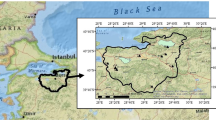Abstract.
Geophysical, geochemical, and hydrogeological parameters, for example longitudinal unit conductance (S), transverse unit resistance (T), total dissolved solids (TDS) and thickness of the weathered zone (Wz), have been compared for 25 sites of Navalgund taluk in Dharwar District of Karnataka State, India. Interrelation among these parameters has been analyzed quantitatively by the standard statistical technique leading to a suitable mathematical model. The contrasting geophysical, geochemical, and hydrogeological characteristics of the fresh water pockets in the regionally brackish aquifers are compared and illustrated. The study explains the significant bearing of these parameters on exploration, development, and exploitation of fresh groundwater sources in the areas affected by the occurrence of a brackish water aquifer. The importance of such a comparison in raising the confidence to identify a fresh groundwater aquifer in the brackish terrain by quantitative interpretation of resistivity data has been demonstrated.
Similar content being viewed by others
Author information
Authors and Affiliations
Additional information
Electronic Publication
Rights and permissions
About this article
Cite this article
Hodlur, .G., Prakash, R.M., Deshmukh, .S. et al. Role of some salient geophysical, geochemical, and hydrogeological parameters in the exploration of fresh groundwater in a brackish terrain. Env Geol 41, 861–866 (2002). https://doi.org/10.1007/s002540100340
Received:
Accepted:
Issue Date:
DOI: https://doi.org/10.1007/s002540100340




